Bounce rate and exit rate – what’s the difference and which is more important? These two metrics are often confused with each other. But they measure very different things.
In this article I’ll explain the difference between bounce rate and exit rate, I’ll explain some other metrics closely related to bounce rate, and I’ll give you some tips for reducing your bounce rate.
Let’s dive in.
What Is Bounce Rate?
Bounce rate is defined as the percentage of visitors to your site who arrive at your site on a particular page and then navigate away, or ‘bounce’, from your site after only viewing that single webpage.
Bounce rate definition
A bounce is only recorded if a user exits from the same page they entered your website and does not interact with any of the components on that page (e.g. doesn’t fill out an opt-in form, doesn’t leave a comment etc).
The key characteristic of a bounce is that it is always a one-page session.
What does high bounce rate indicate?
A high bounce rate is usually a negative for most websites. It indicates that there was nothing else on your website that was relevant to your visitor.
High bounce rate is not always bad
However, high bounce rate is not always a bad signal.
Some pages, such as lead capture landing pages, deliberately contain no links to any other page so that the visitor is entirely focused on completing the action that the page is targeting (i.e. submitting an email address). This kind of page will inevitably produce a high bounce rate.
Similarly, a blog post that exactly answers the question that a searcher typed into Google will often have a high bounce rate. Far from being a negative, a high bounce rate in this situation indicates that your content delivered what your visitor wanted. The searcher found what they wanted and then left.
Industry standards for bounce rate
Some industries or types of website by their nature have higher bounce rates than others. Here are some typical bounce rates by industry, provided by MonsterInsights:
- Retail Sites: 20 %– 40%
- Simple Landing Pages: 70% – 90%
- Portals: 10% – 30%
- Service Sites: 10% – 30%
- Content Sites: 40% – 60%
- Lead Generation sites: 30% – 50%

Conversion XL notes that blog sites typically have higher than normal bounce rates. Compared with service sites, with a typical bounce rate of 10% – 30%, blogs typically have a bounce rate of 70% – 90%:
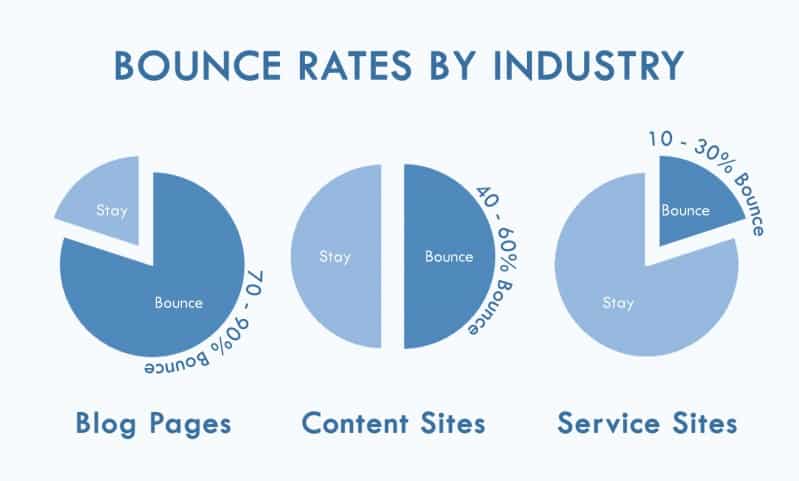
Where to see your bounce rate
To see your bounce rate, login to Google Analytics and then go to Behaviour > Site Content > All Pages:
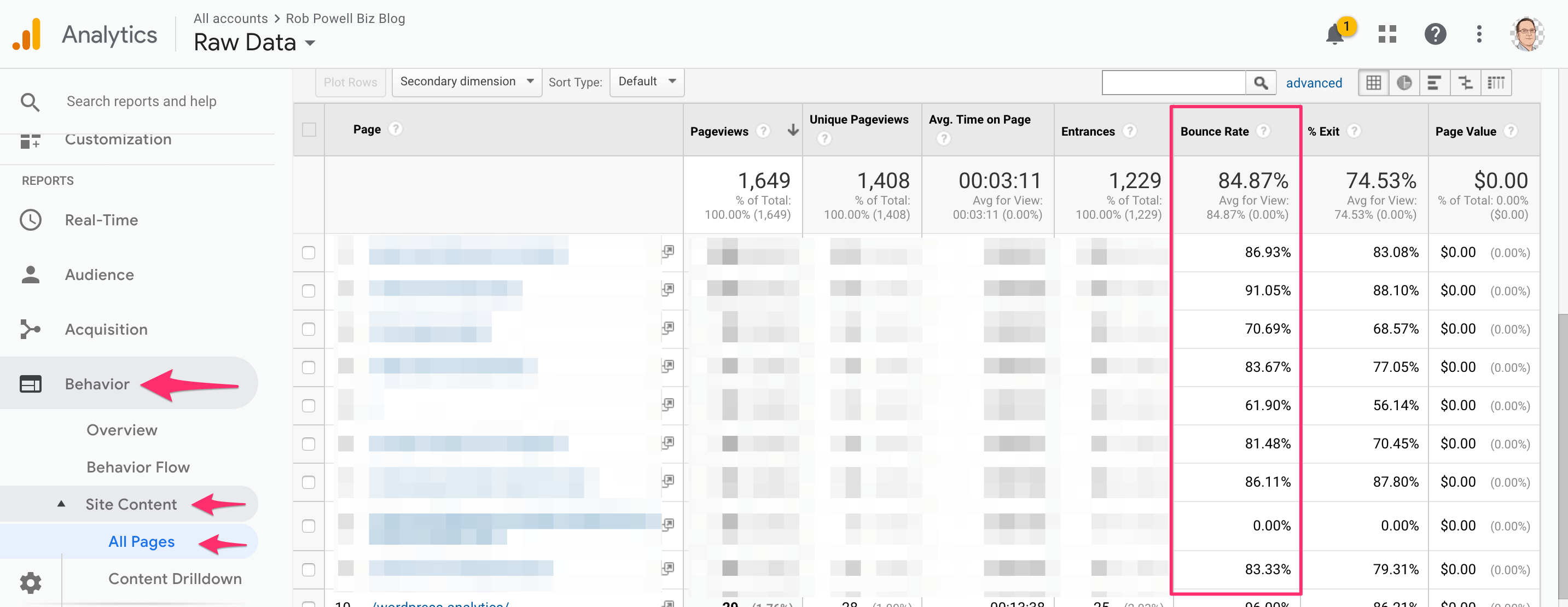
What Is Exit Rate?
The exit rate for a particular page is the percentage of people who left your site from that particular page.
Whereas bounce rate only records visitors who entered and exited your site from the same page, exit rate includes single-page and multi-page sessions. Exit rate is not concerned about where a visitor entered your site, only with the page from which they exited.
What does high exit rate indicate?
As with bounce rate, a high exit rate is not necessarily negative. It may simply indicate that the visitor found what they were looking and then left your site.
However, a high exit rate on a page that is intended to take your visitors further into your site is a sign that something is wrong. High exit rates on particular pages often indicate a problem in your conversion funnel.
Where to see your exit rate?
To find your exit rate in Google Analytics, go to Behavior> Overview:
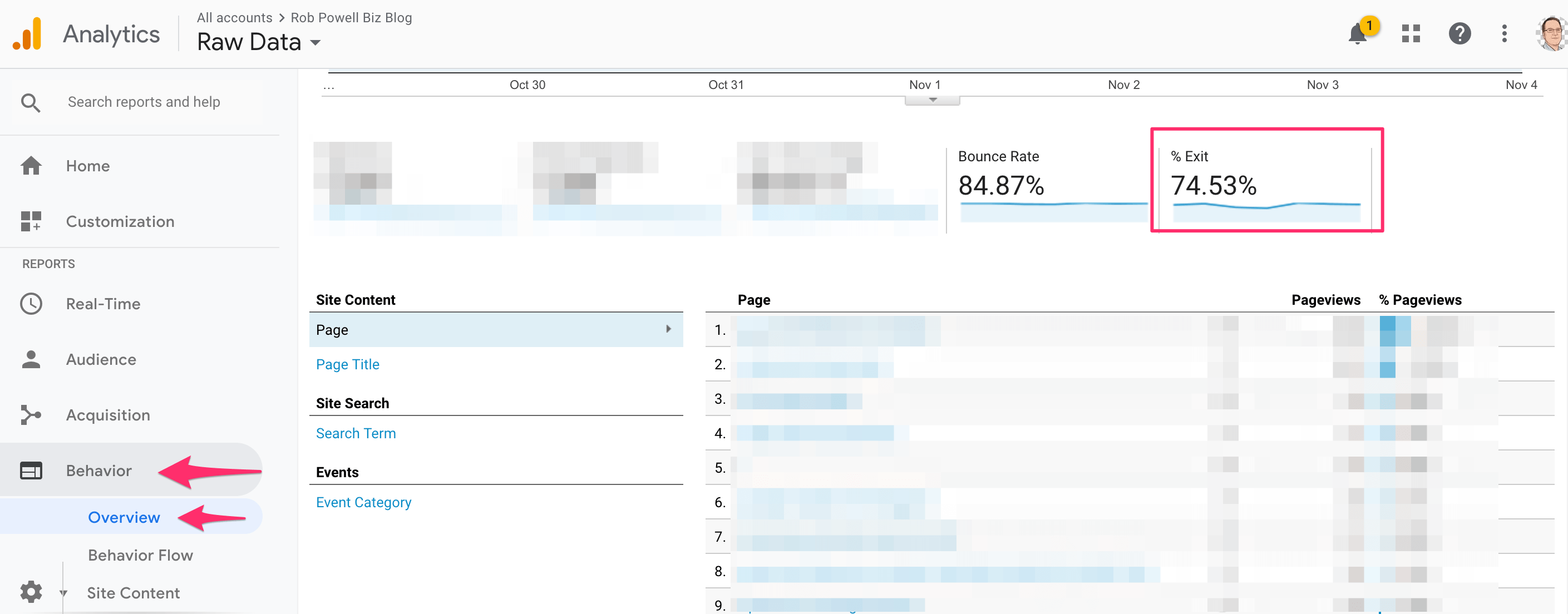
You can also find your exit rate by going to Behavior >Site Content > All Pages:
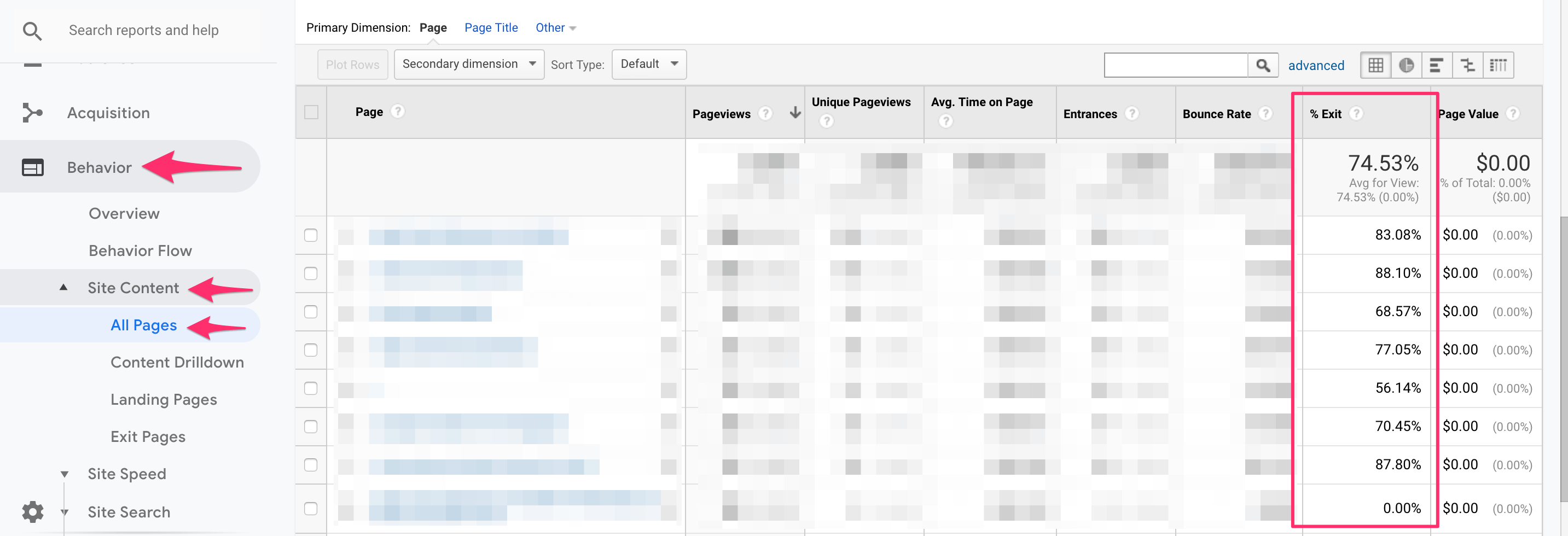
Bounce Rate vs Exit Rate: What’s the Difference?
Bounce rate and exit rate are often confused with each other, so here are some differences between the two:
- Bounces are always one-page visits whereas exits can refer to multi-page visits
- Bounce rate refers to the first page a visitor lands on when entering your site, while exit rate refers to the last page a visitor is on before they exit your site
- Exit rate is the percentage of visits where a particular page was last in the session, whereas bounce rate is the percentage of visits where that page was the only page visited in that session
Bounce Rate and SEO
Google has often stated that it doesn’t use bounce rate as a ranking factor in their algorithm.
And there are good reasons to believe this is the case.
Firstly, it would create an uneven playing field, since about half of all websites in the world are not registered with Google Analytics (in other words, Google would have no bounce rate metrics for these sites).
Secondly, as we have seen above, a high bounce rate is not necessarily a negative – it may simply mean that the page perfectly addressed the searcher’s query.
Thirdly, standard bounce rates vary enormously between industries.
But the question remains: does a high bounce rate negatively impact SEO?
LarryKim of Moz analysed content on the Moz site and found that there was a detectable relationship between bounce rate and SERP ranking: pages with higher bounce rate ranked lower in the SERPS:
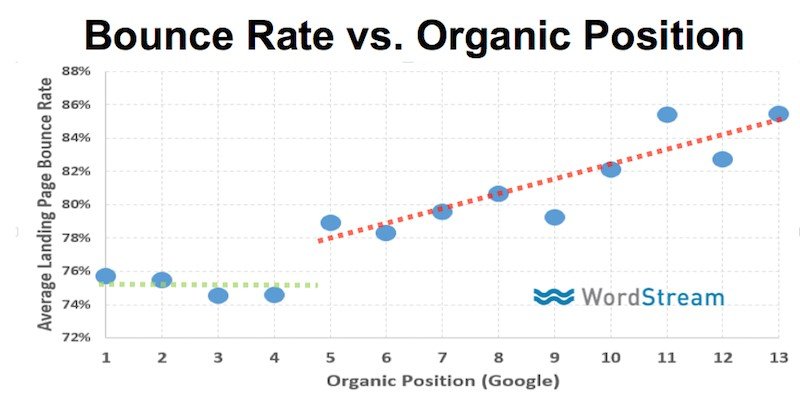
And Backlinko, in a study of over one million Google search results, found a clear correlation between bounce rate and Google ranking:
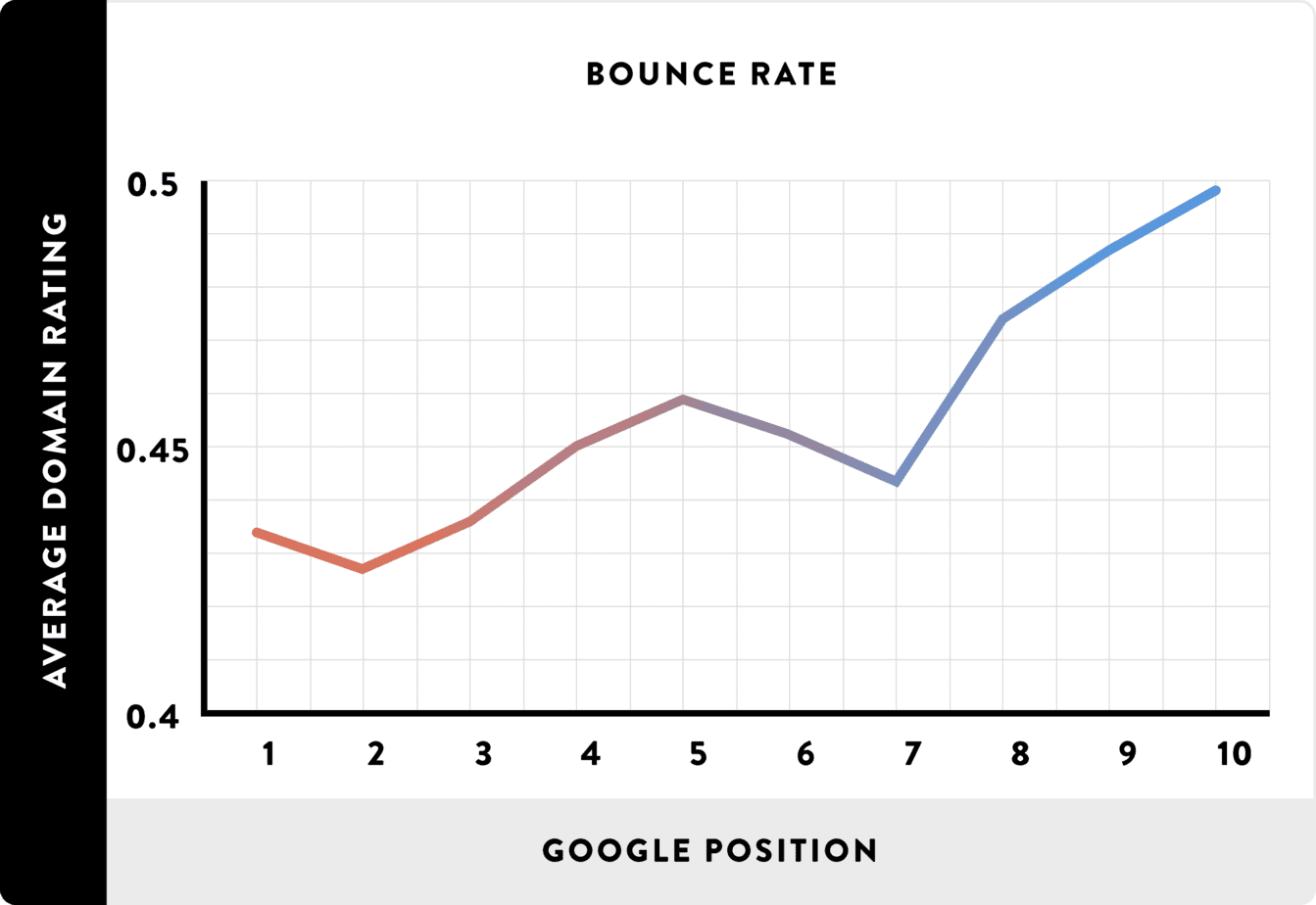
So it seems that bounce rate does play a role in where your page appears in the search results.
Bounce Rate vs. Return to SERP
There’s another metric, besides bounce rate, that search engines watch very carefully.
It’s called ‘return to SERP’ and it measures the time a visitor spends on your page before clicking back to the SERPs.
A return to SERP is a bounce but unlike other bounces it’s a bounce that is always negative.
Put simply ‘return to SERP’ records the amount of time a visitor spends on your page before returning to the SERPs.
The reason a high ‘Return to SERP’ is bad for your search rankings is it tells Google that your page did not answer the visitor’s search query. And since Google’s main concern is improving the match between search query and search results, a page with high ‘return to SERP’ will quickly move down the search results.
Bounce Rate and Pogo-Sticking
Pogo-sticking is when a searcher clicks on a SERP listing, realizes the page doesn’t answer their query, and quickly clicks back to the search results.
Pogo-sticking is what happens when a page has a high rate of ‘return to SERP’. Whereas a bounce can be positive or negative, a high incidence of pogo-sticking is always negative.
No one knows exactly how short a visit has to be to trigger the pogo-sticking algorithm. But it’s clear that the shorter the interval between arriving on your page and returning to the SERPs, the more likely this algorithm will be triggered.
Google tracks pogo-sticking by recording short clicks and long clicks. Short clicks are where a visitor clicks on search results and quickly clicks back to the SERPs page. Long clicks indicate a satisfied searcher.
How To Reduce Bounce Rate
So now that we’ve covered what bounce rate is and how it differs from exit rate, dwell time, return to SERP, and pogo-sticking, you maybe wondering how can reduce bounce rate.
Especially since the evidence indicates that there is a correlation between high bounce rate and lower search engine rankings.
Avoid large blocks of text
Break your text up with headings, bullet points and images. Nothing turns visitors away quicker than large, dense blocks of text.

Give your page a single and clear call-to-action (CTA)
Every web page should have a purpose, something you want the visitor to do, for example:
- sign up to an email list
- share a page on social media
- write a comment
- leave a review
Make it clear to your visitor what you want them to do by including a clear call to action (CTA).
Optimize page load time
According to Kissmetrics 47% of people expect a web page to load in less than 2 seconds. Use the tips in this article to make your web pages load faster.
There are some more tips for reducing page load time in this excellent article by Ankit Singla on 17 Effective Tips To Reduce Blog Page Load Time.
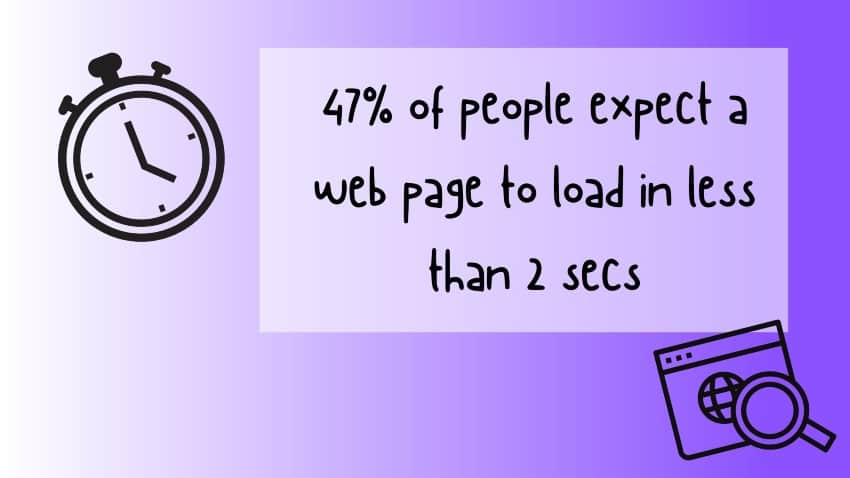
Go easy on distracting sidebar widgets
Keep those flashing, brightly colored widgets in your right sidebar to a minimum. After all, you want your visitors to read your content, so don’t distract them.
Optimize for mobile
Check in Google Analytics to see if you have a high bounce rate on mobile devices. If so, optimize your site for mobile.
Write shorter sentences and paragraphs
Paragraphs and sentences on the Internet need to be much shorter than in print media.
Keep your paragraphs to no more than three sentences and try to keep your sentences to no more than 25 words.
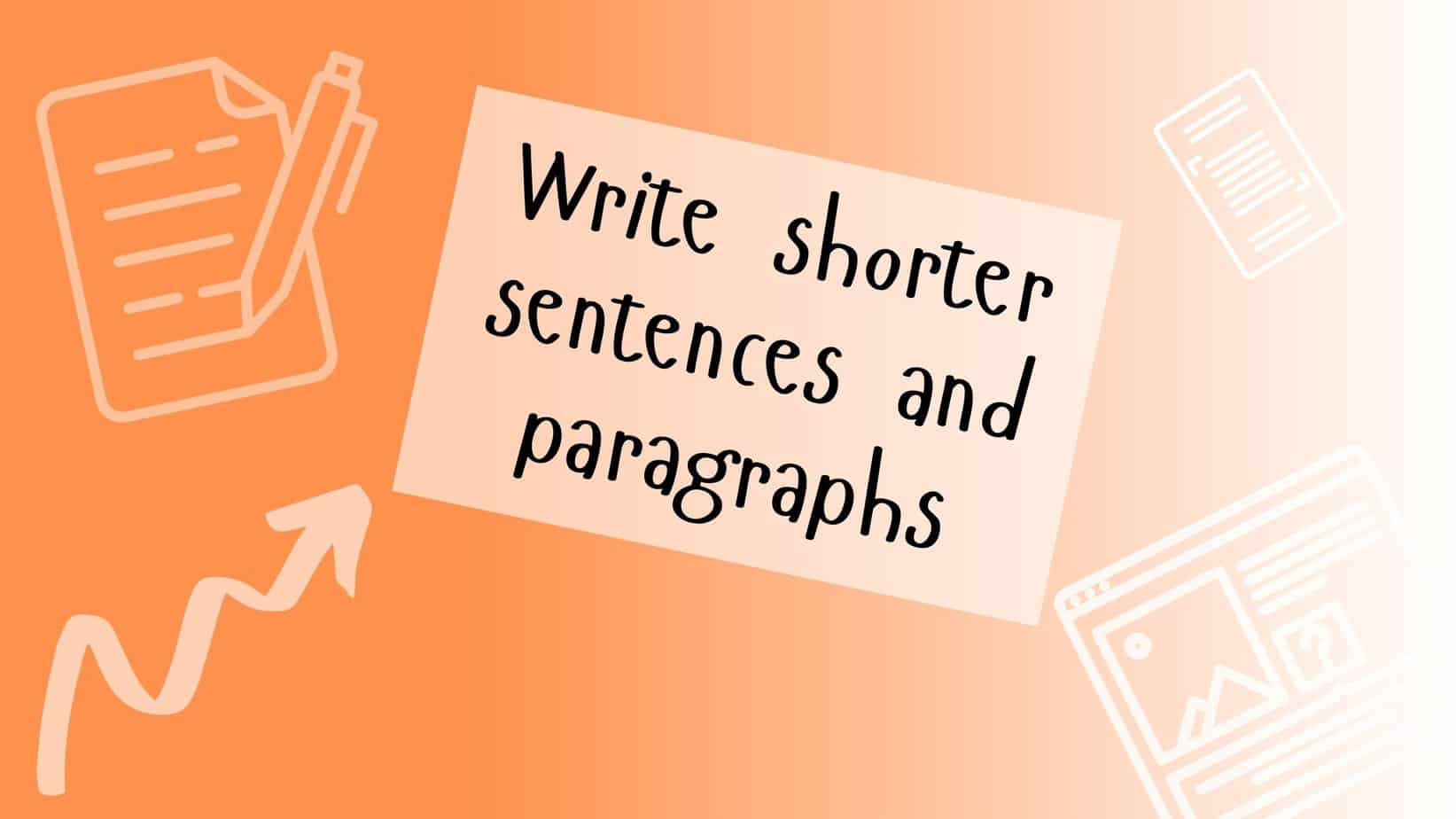
Mix up your content
Use a mix of different types of content along with your text. Use plenty of images and include one or two YouTube videos on the topic of your web page.
Use relevant keywords
Make sure your web page is ranking for relevant keywords. If your page is getting traffic from irrelevant search queries, that’s going to result in a high bounce rate.
Avoid aggressive popups
Most people find popups that load as soon as you arrive on a page annoying. If you use popups, make sure they are exit-intent only.
Use internal linking
Encourage your visitors to explore your site by sprinkling your content with relevant internal links. As soon as visitor clicks through to another page on your site, their visit will no longer be recorded as a bounce.
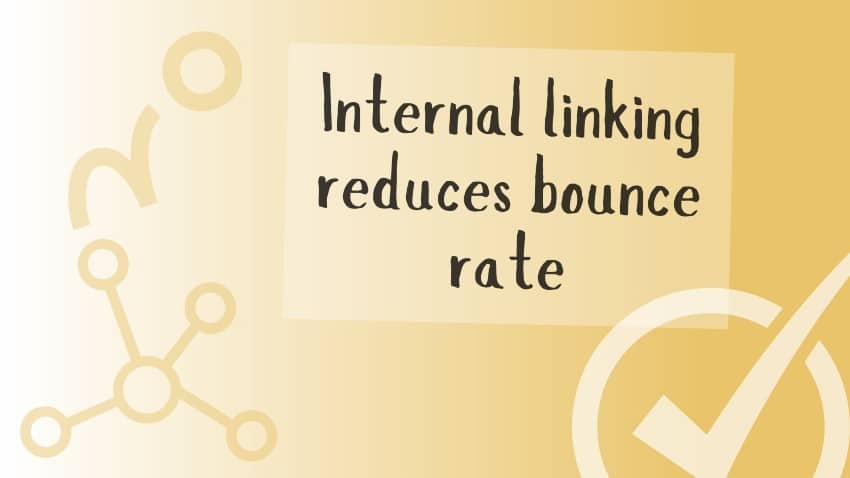
Ensure that all links open in a new tab
Make sure all your links open in a new tab – if your links open in the same tab, your reader will lose your page as soon as they click on a link.
The best WP plugin for ensuring that all your links open in a new tab is OpenExternal Links In a New Window.
Improve the readability of your text
Run your web page copy through an app like Readable, or Hemingway.
Use transitions
Transitions are short sentences that link one paragraph with the next.
They keep people reading and stop them bouncing away. For more on how to use transitions, see my guest post on SmartBlogger.
Conclusion
There’s a lot of confusion around bounce rate vs exit rate – they are similar metrics that appear to be the same. But they measure different things.
The key difference is that bounce rate measures exits from single-page sessions, whereas exit rate measures exits from all sessions (single- and multi-page).
Although high bounce rate is not always a negative, in most cases you should try to reduce it.
Use the tips in this article to get your bounce rate as low as possible as it is probably a factor that search engines take into account when ranking content.
I just started to work in a company and I wanted to learn about SEO (on-page), so I was searching for an article on the internet and I got your article and I must say it helped me a lot to understand what are the differences between bounce rate and exit rate. Thank you very much for this lovely article.
Hi Sunny,
Thanks, you’re welcome, I’m glad it was useful.
All the best, Rob.
I am very pleased to learn the true concept behind the major differences in between bounce rate vs exit rate, I was searching like this, to the point guide and luckily Google landed me on the right page.
Appreciate Rob Powell, for this master powerful guide and i do love to share the same strategy on my YouTube (MR VYAS) channel blogging community, once again very thankful
Hi Kirtish,
Thanks for your feedback – glad it was helpful.
All the best – Rob